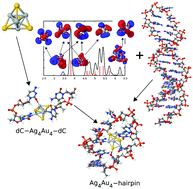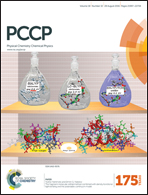DNA-stabilized Ag–Au bimetallic clusters: the effects of alloying and embedding on optical properties†
Abstract
Global geometry optimization and time-dependent density functional theory calculations have been used to study the structural evolution and optical properties of AgnAun (n = 2–6) nanoalloys both as individual clusters and as clusters stabilized with the fragments of DNA of different size. We show that alloying can be used to control and tune the level of interaction between the metal atoms of the cluster and the organic fragments of the DNA ligands. For instance, gold and silver atoms are shown to exhibit synergistic effects in the process of charge transfer from the nucleobase to the cluster, with the silver atoms directly connected to the nitrogen atoms of cytosine increasing their positive partial charge, while their more electronegative neighbouring gold atoms host the excess negative charge. This allows the geometrical structures and optical absorption spectra of small bimetallic clusters to retain many of their main features upon aggregation with relatively large DNA fragments, such as a cytosine-based 9-nucleotide hairpin loop, which suggests a potential synthetic route to such hybrid metal–organic compounds, and opens up the possibility of bringing the unique tunable properties of bimetallic nanoalloys to biological applications.


 Please wait while we load your content...
Please wait while we load your content...